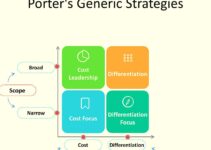Retailing is a process where manufacturers and producers sell their products to wholesalers and distributors at a lower price. They ultimately sell their products to the end consumers at a higher price that would cover labor, marketing, storage, inventory, and other expenses. Today, we’ll discuss what is retail marketing; its various types, importance, and strategies.
What is Retail Marketing?
Retail marketing comprises a set of strategies and actions that retailers implement in order to sell the products of other brands. The retailing process comprises various activities like buying products from other wholesalers and distributors in their specific field, advertising and promoting them, and developing the connection with the target customers.
The retailing stores can be online and offline; Walmart is a physical offline store, and Amazon is an online store. They both are the world’s leading giant stores in their specific categories. According to an estimate, the annual revenue of Walmart in 2019 was 331 billion dollars.
If you want to achieve success in retailing business; then you should launch effective promotional and advertising campaigns to connect with the target customers, develop attractive packages, and sell products at a good competitive price range.
Importance of Retail Marketing
The retail marketing business is important because of three main reasons;
Helping Small Producers
Some well-established retailers help small manufacturers and producers by advertising and promoting their products to the target customers. It is beneficial for both parties; because the small businesses have got a limited budget, and they can’t afford the multiple media ad campaign. However, only a few people are aware of their brand and the products and services they’re offering. The retailers would get the opportunity to offer local unique products to their customers.
Gathering Data
Since retailers have got a platform that customers visit all the time and they gather customers’ information in the meantime. The manufacturers and products don’t have the access to the customers’ data. When both partners cooperate with each other; then producers would develop better products based on the need and wishes of customers, and the sale of retailers would increase resultantly.
Link with Manufacturers
There are different retailers and they sell various types of products and services to the customers. Manufacturers and producers should sell their products on the right platform. For instance, if you’re producing bicycles, then you should offer your bicycles at the bicycle retail store because they would increase your sale and production.
Types of Retail Marketing with Examples
Some of the main types of retail marketing along with examples are as follows;
Departmental Stores
Departmental stores are those types of big retailers that offer various products in broad categories in a single store like electronics, food, clothing, hardware, and others. They offer various products in separate labeled areas. For instance, Walmart and Target are the leading departmental stores.
Franchises
Franchising is a type where a very popular brand gives permission to local retailers to open up stores under its brand name and follow its manufacturing processes and identity. It provides great exposure to the franchisers and the local store owners would earn a lot of profit by using the brand name of the franchise. Some of the multinational franchises are Wendy’s, Starbucks, and McDonald’s.
Supermarkets
The focus area of supermarkets is on the sale of food items, but it also offers a wide range of other household products with narrowed-down options as compared to the departmental stores. For instance, Whole Foods Market and Aldi are the leading examples of supermarkets.
Shopping Centers & Malls
Shopping centers and malls are very big buildings containing various retailing stores them. It offers customers an opportunity to find and purchase anything they want in one place. However, the owners design the shopping mall so easy and comfortable that people spend more time there and buy things.
Many malls have got restaurants, cinemas, and games for people to eat, watch movies, and play games along with shopping. For instance, Aventure and Tysons Mall are the leading examples of malls.
Online Stores
Technological development and the internet have allowed customers and people to buy things online from their computers and smartphones without going anywhere. For instance, eBay and Amazon are the leading examples of online stores.
Discount Stores
Discount stores are the type of retail stores that focus on the lower income families and offer them the affordable necessary products for daily routine life. The quality of the products in the discount stores isn’t very good, and that’s why they offer them at a lower price.
Strategies of Retail Marketing
The objective of retail marketing strategies is to differentiate the retail store from the competitors and gain a competitive edge in the market. It would increase the retailers’ profitability and sales ultimately. Some of the main strategies of retailing are as follows;
Limited Offers & Discount Period
Limited offers and discounted period focuses on increasing sales temporarily. It spreads out the word of marketing of the company and attracts the attention of more customers and makes them repetitive.
Price Drops
As the name implies, it focuses on offering the customers the same quality and quantity of products at a lower price than competitors. Price dropping is a great way to attract the attention of customers.
Retail Branding
The retailer develops a brand position, logo, and brand name for its retail stores and associates the top qualities with its brand name. It attracts the attention of customers and makes them buy from the branded store rather than the unbranded store.
Strategic Placement
The retailer places its product items specifically in those rackets, places, and areas where customers are more likely to check them out. The strategic placement amplifies the sale of the store. For instance, placing small and low-price products at the counter would increase its sales.
Strategic Store Design
The design and layout of the store make a great impression on the customers. Such a design that focuses on serving customers and making them comfortable would perform better than the one that won’t. For instance, a classic layout is appropriate for the men’s dressings; a child-friendly color design is appropriate for the toyshop.
Visual Merchandising
The appearance of the retail store matters. If the store looks good, then it would attract customers to visit your store and buy things from you. The increase in the sale of the store would amplify its profitability.
Loyalty Programs
The focus of loyalty programs is to develop a relationship with customers and make them visit your store repetitively. Retailers could win customers’ loyalty by offering them exclusive discounts, rewards, and coupons.
In-Store Ads
Customers usually like the advertised brand over others while shopping. The smart placement of the ads at various points would amplify the sale of the promoted product.
Employees Training to be Smart
Some retailers focus on providing training to their employees so that they would influence the mind of customers while shopping. Better informed and trained employees increase sales significantly by developing a relationship with customers.
Conclusion: What is Retail Marketing? Importance, Types, Strategies
After an in-depth study of what is retail marketing; its importance, types, strategies, and examples; we have realized that retailing is highly important for businesses and companies. If you’re a retailer, then you should follow and practice the abovementioned tips and suggestions.

Ahsan Ali Shaw is an accomplished Business Writer, Analyst, and Public Speaker. Other than that, he’s a fun loving person.


